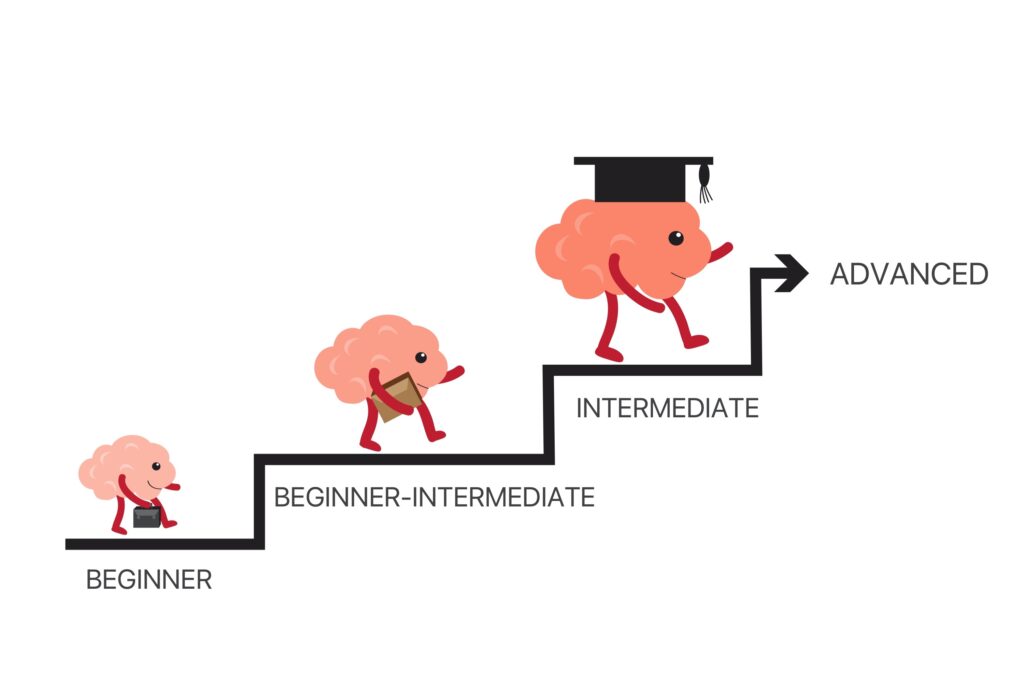
PRACTICE TIPS
Set a fingerstyle guitar goal
Setting a guitar playing goal to give yourself a “reason why” for all your practice
The ONE thing necessary to play great guitar
Having taught dozens of guitarists in person and with over 13k online students, people often ask me “what is the ONE biggest factor in student success?”
The answer might surprise you because it’s not about ability or having lots of time to practice.
It doesn’t matter whether the student has fat fingers or small hands, or whether they are young or old.
The real success factor that matters is working with the student to set a learning goal.
The mistake I often see is that the goal is too reasonable or too easy. The best outcome is when the student is excited by the goal.
So how would you feel about finding your own ideal goal – achievable in the next 30 days?
Read on.
Beginner Level Fingerpicking
If you are completely new to guitar, you might spend your first 30 days learning to fingerpick by achieving ALL the following skills
- Learning the six most common chords (G, C, D, Am, Em and E)
- Fingerpicking with the correct right-hand fingers (the big rule of fingerpicking)
- Playing the bass note on different strings
Play a simple fingerpicking piece using the appropriate right-hand fingers and playing bass with the thumb – changing over a few chords
Beginner-Intermediate Level Fingerpicking
When students begin to fingerpick using the right technique, the next area of development is usually to make the thumb more independent.
The left hand is fretting chords while the right hand fingerpicks – but the thumb is now doing more work, playing bass notes on several strings. The eventual result can be Travis Picking style playing – but even just getting that thumb to play bass notes on different string (over one chord) is great progress.
BEGINNER-INTERMEDIATE GOAL:
Play different bass notes while picking the notes of a chord
Intermediate Level Fingerpicking - Strum & Fingerpick
The guitarist at this stage has several options for how to develop.
Ask yourself which of these sounds the most appealing – because if you’re motivated to master something, the chances are that you probably will!
Mixing strumming and fingerpicking of chords can be a very rewarding skill. This can lead to a boom-chuck style of playing with a mix of bass, chords and rhythm.
– Learn to mix strumming and fingerpicking (example: use the boom-chuck pattern)
Intermediate Level Fingerpicking - Picking Arpeggios
A core intermediate skill is to mix learning scales and playing arpeggios within that scale while keeping a bass-line down.
This is a great way to get the sound of more than one guitarist playing – because you are doing both the lead and the bass (and maybe throwing a few chords in there too!)
INTERMEDIATE GOAL OPTION 2:
– Learn the major scale and play arpeggios in that scale while fingerpicking
Intermediate Level Fingerpicking - Blending melodic lines & bass
The core intermediate skill for me is being able to introduce some lead guitar playing. If you play lead guitar, you will often express yourself by sliding notes, bending notes or hammering on or pulling off certain notes. Being able to mix a melody featuring these expressions with a solid bass-line is the main goal that I would challenge the beginner (yet not novice) fingerpicker to master.
INTERMEDIATE GOAL OPTION 3:
– Master a fluid melody line with hammer-ons, pull-offs and slides and blend this with a bassline
Advanced Level Fingerpicking - Polyrhythm, Percussion & Tunings
The intermediate guitarist can now focus on any one of a number of areas depending on their preferences.
Learning polyrhythms can allow the guitarist play something melodic in one time rhythm while playing the bass in another ‘count’ to create a really impressive multiple-part sound.
Playing and writing in different tunings can also open up the entire timbre of the guitar and hugely open up possibilities
Adding percussive elements to playing is another advanced skill which can allow you to develop your own voice.
ADVANCED GOAL OPTIONS:
Any one of the following would be a good advanced goal
– Learn a polyrhythm (e.g. 3/2) and play a fingerpicking pattern in this polyrhythm
– Add percussive elements to your playing
– Play and compose in an alternate tuning
Advanced Level Fingerpicking
Advanced fingerpicking is generally a composite of many good fundamental underlying techniques.
One option is to get so comfortable playing the bass parts that you can play different bass shapes/lines on each bar.
The end result is that your ability to play ‘lead’ guitar riffs or solo lines increases dramatically..
ADVANCED GOAL OPTIONS:
– Fingerpicking pieces that use different bass patterns throughout the song
– Natural blues guitar lead type playing while continuing to fingerpick
SET YOUR GOAL
Now it’s time to set your goal!
Which of the goals above – or any other goal – do you want to set right now? Find a piece of paper and write it down!
Good Luck!
p.s. if you want to start writing your own guitar tab, you can use a software called Guitar Pro which I talk about here.
Get the Learn Fingerpicking Book
Register for the newsletter and I will send you this book (105 pages) and a free lesson once a month.
This is the ideal resource for complete beginners who wish to learn guitar.
